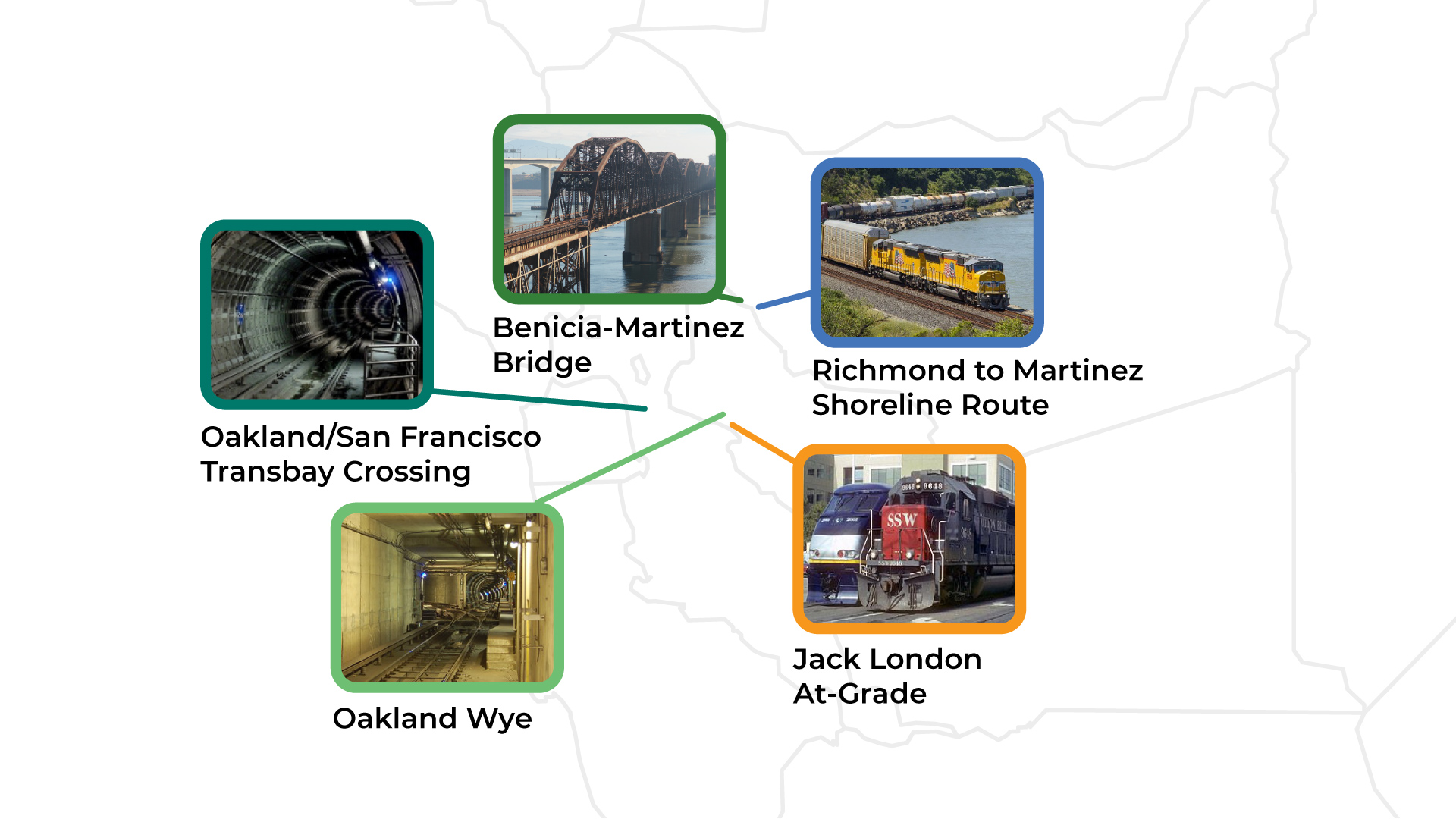Infrastructure refers to physical features of the train system, such as additions and/or improvements like bridges, tunnels, tracks, and stations. Understanding markets, service, and train technology will help the Link21 Team develop recommendations for needed infrastructure improvements.
The Link21 Team has been considering many aspects of future infrastructure and, with the public’s input, will be evaluating many viable alternatives in future phases of work. Regional Rail service improvements will need to be approved by the owners of the rail rights-of-way. Depending on the location of improvements, this could include the Union Pacific Railroad, BNSF Railway, or Peninsula Corridor Joint Powers Board (Caltrain).
The Key to Connection Is a New Train Crossing of the Bay
Supported by voters and backed by previous studies, the Link21 Team is planning a new train crossing between Oakland and San Francisco. Our preliminary Market Analysis data shows that a new train crossing will fill a huge service gap, reduce greenhouse gas emissions, and relieve the worst transportation bottlenecks in Northern California.
A new crossing will also unlock the potential to improve travel by train in the Megaregion by facilitating new connections on either side of the crossing. Together with other rail improvements being planned and implemented by other partners in the Megaregion, a new train crossing of the Bay and additional Link21 improvements will make train travel around the Megaregion more connected and convenient.
Link21 Will Not Include a Bridge for Trains
The Link21 Team has considered the feasibility of constructing a passenger rail bridge in lieu of an underground crossing. However, because the area between San Francisco and Yerba Buena Island is a major shipping channel, a bridge would need to be very high to allow ships to pass beneath it.
The new train crossing of the Bay will most likely connect to an existing underground station, such as the Salesforce Transit Center. Getting from deep underground to a high bridge over the shipping channel would be too steep for most trains. Therefore, a very long ramp would be needed through San Francisco’s urban area, which is not feasible.
The Link21 team is therefore recommending excluding a bridge option from further consideration.
Other Major Opportunities to Transform Our Train Network
In addition to a new train crossing of the Bay, the Link21 team has identified additional major infrastructure opportunities to consider as we work towards the vision of connecting Northern California.
There are a number of constraints on the current megaregional train network that will shape the Link21 Program and the train service improvements it provides. These constraints directly challenge Link21 Program development and will be addressed by Link21 and partner agencies.

Suisun Bay (or Benicia-Martinez Rail) Bridge
The Suisun Bay or Benicia-Martinez Rail Bridge is a vertical lift bridge built nearly a century ago. The center span of the bridge opens for the passage of large ships and vessels through the Carquinez Strait. There's no way to reliably schedule the passage of ships. Therefore, trains must wait and can be unreliable when ships are present.
Richmond to Martinez Shoreline
The Richmond to Martinez Shoreline route is a beautiful stretch of track that curves around the shoreline. Trains run as slow as 25 miles per hour in some parts. The curves on this route mean that the tracks wear out faster and require more maintenance. This section of track is also vulnerable to sea level rise due to climate change and storm surges. (Sea level rise is an increase in the world's ocean water due to climate change.)
Jack London At-Grade Tracks
The Regional Rail trains at Jack London Square in Oakland are at street level and share space with freight trains, cars, cyclists, and pedestrians. To ensure safety, the trains travel very slowly. Often times freight trains wait on the tracks before entering the Port of Oakland. All of this causes congestion and limits passenger rail service in this corridor.
The Oakland Wye
All BART lines go through the Wye, a low-speed pinch point for the system.
Downtown Extension and Salesforce Transit Center
The Downtown Rail Extension project, managed by the Transbay Joint Powers Authority, will extend Caltrain commuter rail from its current terminus at Fourth and King streets in San Francisco to the new Salesforce Transit Center. In the future, The Salesforce Transit Center will be the San Francisco terminus of the California High Speed Rail system. The Link21 Team has been looking at ways to connect a new transbay passenger rail crossing to the underground level of the Salesforce Transit Center as well.
The Salesforce Transit Center is in a dense urban area. The underground connection to it presents numerous engineering challenges that will likely require a large infrastructure investment.




